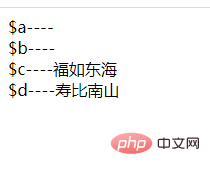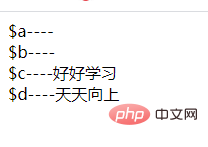Home >Backend Development >PHP Tutorial >Learn to use PHP's List, each function and their coordination
In the previous article, I brought you "How to get PHP super global variables (organizing and sharing)". This article introduces the relevant knowledge of super global variables in PHP in detail. This article In this article, let’s take a look at the relevant knowledge of list and each functions in PHP to traverse arrays. I hope it can help everyone!

#The list function and each function are functions that we often use in our daily life, so how should we use these two functions? What are the characteristics between the two? How do they work together? These two functions are interesting array functions. It is not difficult to learn the functions, so let’s take a look.
list function
list function its function is: it can download the index array The one marked with 0 corresponds to variable 1, and the one with subscript 1 corresponds to variable 2... The list function can turn the elements of the array into variables.
Its basic syntax is:
list(变量1,变量2...)
The example is as follows:
<?php list($a , $b , $c, $d) = array('好好学习' ,'天天向上' ,'福如东海','寿比南山'); echo '$a----'.$a.'<br />'; echo '$b----'.$b.'<br />'; echo '$c----'.$c.'<br />'; echo '$d----'.$d.'<br />'; ?>
Output result:

It can be seen from this that the subscript of "study well" in the array is 0, which corresponds to $a in the list function; it can also be understood as the assignment of "study well" with a variable of 0 in the array $a in the list function is given; and so on. The list is from left to right, one-to-one corresponding to the subscript value starting from 0 in the index array.
At the same time, there is another situation, the example is as follows:
<?php list( , , $c, $d) = array('好好学习' ,'天天向上' ,'福如东海','寿比南山'); echo '$a----'.$a.'<br />'; echo '$b----'.$b.'<br />'; echo '$c----'.$c.'<br />'; echo '$d----'.$d.'<br />'; ?>
Output result:

In the above example, the subscript The value of Fu Rudonghai of 2 is assigned to $c, and the first two positions in the list are left empty, which corresponds to one-to-one, so study hard and Tiantianxiang have no corresponding variables. Therefore, the list function strictly adheres to the one-to-one correspondence principle, that is, the first variable of the list function corresponds to the element with the subscript 0 in the array, the subscript 1 corresponds to the second variable in the list function, and so on. .
Of course there is another situation, the example is as follows:
<?php list($a , $b , $c, $d) = array(2=>'好好学习' ,'天天向上' ,'福如东海','寿比南山'); echo '$a----'.$a.'<br />'; echo '$b----'.$b.'<br />'; echo '$c----'.$c.'<br />'; echo '$d----'.$d.'<br />'; ?>
Output result:

In In the above example, because the key name of the array starts directly from 2, there are no elements with subscripts 0 and 1 in the array elements, so the variables a and b have no corresponding values. At the same time, only four variables are written in the list function, and Fu Rudonghai and Shoubi Nanshan with subscripts 4 and 5 in the array elements have no corresponding variables.
each function
##eachThe function of the function is to pass in an array. It will split one of the elements into a new array. Do this one element at a time. Move once and operate the next array element in the same way. Execute to the end and return false.
<?php $a=[ 'aaa'=>'好好学习', 'bbb'=>'天天向上', 'ccc'=>'福如东海', 'ddd'=>'寿比南山' ]; //第一次each $data = each($a); echo '<pre class="brush:php;toolbar:false">'; var_dump($data); echo ''; ?>Output result:

<?php $a=[ 'aaa'=>'好好学习', 'bbb'=>'天天向上', 'ccc'=>'福如东海' ]; //第一次each $data = each($a); echo '<pre class="brush:php;toolbar:false">'; var_dump($data); echo ''; //第二次each $data = each($a); echo '
'; var_dump($data); echo ''; //第三次each $data = each($a); echo '
'; var_dump($data); echo ''; //第四次each $data = each($a); echo '
'; var_dump($data); echo ''; ?>Output result:

The cooperation between list and each
<?php $a=[ 'aaa'=>'好好学习', 'bbb'=>'天天向上', 'ccc'=>'福如东海', ]; list($key,$value) = each($a); echo $key. '-----' .$value .'<br />'; ?>Output result:

<?php
$a=[
'aaa'=>'好好学习',
'bbb'=>'天天向上',
'ccc'=>'福如东海',
];
while(list($key,$value) = each($a)){
echo $key. '-----' .$value .'<br />';
}
?>Output result: 
It can be seen from the above results that each loop is executed once, and then one element is moved backward. At the end of the execution, the flash is returned to stop the loop.
Recommended learning: "PHP Video Tutorial"
The above is the detailed content of Learn to use PHP's List, each function and their coordination. For more information, please follow other related articles on the PHP Chinese website!